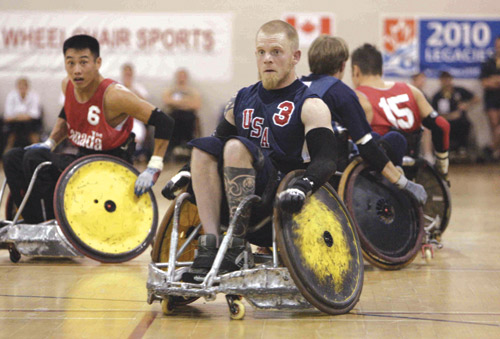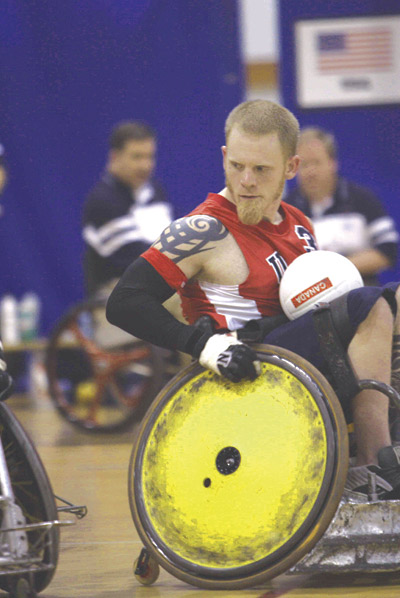| |

|
|
||
| PARK CITY, Utah -- I knew you needed leather balls to play rugby, but I didn't know you could also use steel ball bearings. "Murderball," probably the most talked-about documentary at Sundance this year, is about the extreme sport of wheelchair rugby, played in reinforced and armored chairs by quadriplegics with various degrees of disability. It is a full-contact sport. The film follows the fortunes of Team USA, undefeated for 11 years in the annual tournaments, and one of its stars, Mark Zupan, who intimidates opponents with a fierce goatee and bold tattoos. Another player, Joe Soares, was all-American for years, but has been dropped from the team. In revenge, he becomes coach of the Canadian team, setting up fierce duels at a tournament and also at the 2004 Athens Paralympics. |
||||
 |
||||
| The movie works first of all as an astonishing sports documentary. The rules are simple: When you have the ball, you have to dribble or pass within 10 seconds. Cross the goal line with the ball, and you score. Degrees of disability are rated from 0.5 to 3.0, and a team is allowed to field players totaling eight points. One of the best American players has no lower arms or legs.
|
|
|||
 |
||||
|
|
But the heart of "Murderball," directed by Dana Adam Shapiro and Henry Alex Rubin and produced by Jeff Mandel, is the story of overcoming injuries and despair, and learning through rehabilitation and training not only to function in the everyday world, but to become Olympians. The movie is very frank about details of quadriplegia, including questions about sexuality (yes, many quads can). Most people think all quads are paralyzed from the neck down, like Christopher Reeve, but we find there are degrees of paralysis and many retain various degrees of control of their limbs. |
|
||
They talk about how people are awkward around them, and don't know what to say, and Zupan says: "Hey, I'm shorter than you because I'm in this chair. That's about it." During a school visit, an 8-year-old displays the openness of children when he asks the player without forearms: "How do you eat your pizza?" He finds out. Also how he cooks, drives, and plays quad rugby. There is controversy here this year about two recent films in which paralyzed characters decide that they want to die. Listen to Mark Zupan, who is attending Sundance with his best buddy, Christopher Igor. In high school, it was Chris who crashed his pickup, not realizing Mark was asleep in the truck bed. Mark was thrown into a canal where he awaited rescue for 13 hours. |
||||
|
|
They went through a period of blame and guilt, they said, before finally accepting that it was an accident. They're best friends again. An audience member asked, "If you could, would you turn back the clock on that day?" Zupan, whose full time job is as a civil engineer, answered slowly and seriously: "No, I don't think so. My injury has led me to opportunities and experiences and friendships I would never have had before. And it has taught me about myself." A pause. "In some ways, it's the best thing that ever happened to me. -- Roger Ebert, Chicago Sun-Times, January 2005
Distributed by ThinkFilm Inc. |
|
||
|
|